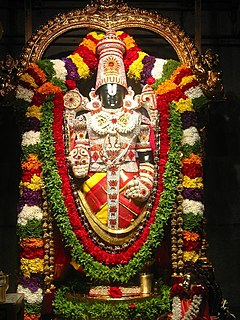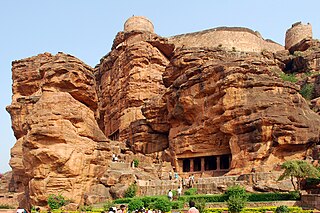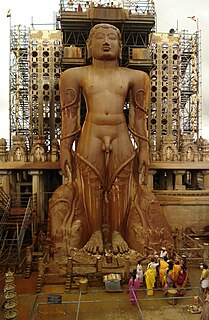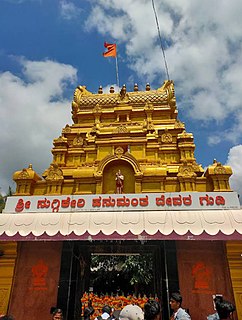
Venkateswara, also known by various other names, is a form of the Hindu god Vishnu. Venkateswara is the presiding deity of Tirumala Venkateswara Temple located in Tirupati, Andhra Pradesh, India.

Badami, formerly known as Vatapi, is a town and headquarters of a taluk by the same name, in the Bagalkot district of Karnataka, India. It was the regal capital of the Badami Chalukyas from CE 540 to 757. It is famous for its rock cut monuments such as the Badami cave temples, as well as the structural temples such as the Bhutanatha temples, Badami Shivalaya and Jambulingesvara temple. It is located in a ravine at the foot of a rugged, red sandstone outcrop that surrounds Agastya lake. Badami has been selected as one of the heritage cities for HRIDAY - Heritage City Development and Augmentation Yojana scheme of Government of India.

Bagalakote district, is an administrative district in the Indian state of Karnataka. The district headquarters is located in the town of Bagalakote. The district is located in northern Karnataka and borders Belgaum, Gadag, Koppal, Raichur and Bijapur. The new Bagalakote district was carved out of Vijayapura in 1997 via Government of Karnataka directive Notification RD 42 LRD 87 Part III. The bifurcated Bagalakote district consists of nine taluks — Badami, Bagalakote, Bilagi, Guledgudda, Rabkavi Banhatti, Hunagund, Ilkal, Jamakhandi and Mudhol.

Arsikere is a city and taluka in the Hassan district in the state of Karnataka, India. It is one of the largest city in Hassan district. Arsikere city municipal council consists of 31 wards.This region is known for its coconut production and is also called as kalpataru nadu. Arsikere is the taluk headquarters, a major railway junction on the South Western Railway which links Mangalore and Mysore to North Karnataka and a central place for tourists who visit nearby places that do not have rail access, such as Belur, Halebidu and Shravanabelagola.

North Karnataka, is a geographical region in Deccan plateau from 300 to 730 metres elevation that constitutes the region of the Karnataka state in India and the region consists of 13 districts. It is drained by the Krishna River and its tributaries the Bhima, Ghataprabha, Malaprabha, and Tungabhadra. North Karnataka lies within the Deccan thorn scrub forests ecoregion, which extends north into eastern Maharashtra. Most parts of the region has black fertile soil ideal for agriculture.
Kaladgi is a panchayat village in the Bagalkot Taluk, Bagalkot District of Karnataka State and is located about 25 km by road west of the town of Bagalkot. Kaladgi is well known for its fruit gardens.
Gangavathi is a city, municipality and taluk in the Koppal district of the Indian state of Karnataka. It is one of the main commercial hubs in the Kalyana-Karnataka region. It is also the largest city, in terms of area and population, in the Koppal district. It is called Rice Bowl city of Karnataka, as it has hundreds of rice mills and sends rice to all parts of the country. Gangavati has Asia's first Rice Technology Park.
Ilkal is a City in Bagalkot district in the Indian state of Karnataka. The town is located in a valley that lies in south-east corner of Bagalkot district and is quite close to the borders of Kushtagi taluk of the Koppal district.Now Ilkal city becomes taluk previous the city falls within the jurisdiction of Hungund taluk and lies at a distance of about 12 km (7.5 mi) south of taluk headquarters. Between these two towns, Ilkal is an important centre of trade, commerce, education, and industry. Ilkal is well connected with state and national highways. It is also famous for its hospitality and education institutions.
Kushtagi is a panchayat town in Koppal district in the Indian state of Karnataka. Kushtagi is a taluk center of Koppal district. This taluk has a population of 353,142 as per the 2021 census estimate. In this taluk, pomegranate fruits are popularly grown. To its North lies Ilkal, Gajendragad to the West, Hospet to the South and Sindhanur to the East. Red and black soil can be found in this taluk. There is a Durga Devi temple.
Mundaragi is a municipal town in Gadag district in the Indian state of Karnataka. Mundargi is close to two district headquarters, being 36 kilometres (22 mi) from Gadag and 50 kilometres (31 mi) from Koppal. It is 99 kilometers from Gajendragad. Mundargi is also the taluka headquarter of the same name. Pin code of Mundaragi is 582118.

Karnataka, the sixth largest state in India, has been ranked as the third most popular state in the country for tourism in 2014. It is home to 507 of the 3600 centrally protected monuments in India, the largest number after Uttar Pradesh. The State Directorate of Archaeology and Museums protects an additional 752 monuments and another 25,000 monuments are yet to receive protection. Tourism centres on the ancient sculptured temples, modern cities, the hill ranges, forests and beaches. Broadly, tourism in Karnataka can be divided into four geographical regions: North Karnataka, the Hill Stations, Coastal Karnataka and South Karnataka.

Sri Venkateswara Swami Vaari Temple is a Hindu temple situated in the hill town of Tirumala at Tirupati in Tirupati district of Andhra Pradesh, India. The Temple is dedicated to Venkateswara, a form of Vishnu, who is believed to have appeared here to save mankind from trials and troubles of Kali Yuga. Hence the place has also got the name Kaliyuga Vaikuntha and the Lord here is referred to as Kaliyuga Prathyaksha Daivam. The temple is also known by other names like Tirumala Temple, Tirupati Temple, Tirupati Balaji Temple. Venkateswara is known by many other names: Balaji, Govinda, and Srinivasa. The temple is run by body Tirumala Tirupati Devasthanams (TTD) which is under control of Andhra Pradesh Government. The head of TTD is appointed by Andhra Pradesh Government. The revenue from this shrine is used by Andhra Pradesh government.

Karnataka, a state in South India has a long association with Jainism, a religion which enjoyed patronage of major historic kingdoms in the state such as the Rastrakuta Dynasty, Western Ganga, Kadamba and Chalukya dynasties and the Hoysala Empire. Today the state is home to a number of Jain monuments, such as temples, Gommata statues and stambhas.
Temples of the Indian State of Karnataka illustrate the variety of architecture prevalent in various periods. The architectural designs have found a distinguished place in forming a true atmosphere of devotion for spiritual attainment.

North Karnataka has innumerable sites in the Temple Map of Karnataka, India, with its some of its still surviving monuments going back to the 7th century AD. The Badami Chalukyas were the builders of rock cut caves and ancient temple complexes. At Pattadakal, there are Temples in the Dravidian style along with Temples in styles that were later adopted in Eastern and Central India. The sculptural quality in these temples is outstanding.

Kuknoor is a town in Kukanoor taluk in the Koppal District of the Indian state of Karnataka, which is located about 40 km northwest of Hospet and 7 km from the Mahadeva Temple in Itagi. Kuknoor is known for the temples of the Rashtrakutas and Chalukyas in the town, with the most notable being the Navalinga Temple.

Belavanaki is a village in southern state of Karnataka, India. It is located in Ron Taluka of Gadag district in Karnataka. It belongs to Belagavi Division.

NuggikeriHanuman Temple is one of the oldest and popular Hindu temples in Dharwad, in the state of Karnataka, India. The presiding deity of the temple is Lord Hanuman and the temple complex also houses other deities viz. Lord Rama, Lord Shiva, Goddess Saraswathi, Goddess Durga, Goddess Santoshimata, Lord Venugopala Swamy, and Lord Jagannath. The temple is located at the airport road and 18 km away from central Hubli, Dharwad, Karnataka, India. Devotees come from different regions to this temple. Due to Vishesha Divasa for Lord Hanuman this place gets crowded every Saturday and on Hanuman Jayanti.

The following outline is provided as an overview of and topical guide to Karnataka:













